|
HyperspaceExplorer 0.7.1
|
|
HyperspaceExplorer 0.7.1
|
N - dimensional surface on a vertex array.
More...
#include <Realm.h>

Classes | |
| class | RealmPrinter |
| Auxiliary class encapsulating printing and conversion to std::string. More... | |
Public Types | |
|
typedef std::vector < VecMath::Vector< 4 > > | vertex_container_type |
| Storage type for the vertices. | |
| typedef std::vector< Realm > | realm_container_type |
| Must support push_back, forward iterator, reverse iterator, operator[]. | |
Public Member Functions | |
| Realm () | |
| Default constructor: Realm points to the first vertex in the array. | |
| Realm (unsigned i) | |
| Construct a Realm pointing to a specified vertex. | |
| Realm (const realm_container_type &sr) | |
| Construct a Realm from a number of subrealms. | |
| ~Realm () | |
| Destructor. Frees managed Realms automatically. | |
| unsigned | size () const |
| Returns the number of subrealms the Realm is made of, emulating realm_container_type interface. | |
| void | clear () |
| Returns the Realm to a completely empty state, emulating realm_container_type interface. | |
| void | push_back (const Realm &r) |
| Add a new subrealm to the list, emulating realm_container_type interface. | |
| realm_container_type::iterator | begin () |
| Pointer to first subrealm, emulating realm_container_type interface. | |
| realm_container_type::const_iterator | cbegin () const |
| Const pointer to first subrealm, emulating realm_container_type interface. | |
| realm_container_type::iterator | end () |
| Pointer past last subrealm, emulating realm_container_type interface. | |
| realm_container_type::const_iterator | cend () const |
| Const pointer past last subrealm, emulating realm_container_type interface. | |
| realm_container_type::reverse_iterator | rbegin () |
| Reverse pointer to last subrealm, emulating realm_container_type interface. | |
| realm_container_type::reverse_iterator | rend () |
| Reverse pointer before first subrealm, emulating realm_container_type interface. | |
| unsigned | dimension () const |
| Returns the dimension of the realm. | |
| void | setDimension (unsigned d) |
| Sets the dimension of the realm. | |
| unsigned | toIndex () const |
| Makes a Realm of dimension 0 usable as index into the vertex array. | |
| Realm | extruded (unsigned delta) const |
| Create a new Realm by extruding the present Realm. | |
| Realm | tapered (unsigned taper_index) const |
| Create a new Realm by tapering the present Realm. | |
| Realm | rotated (unsigned num_segments, unsigned size) const |
| Create a new Realm by rotating the present Realm. | |
| void | merge (const Realm &r) |
Merge r into the current Realm, keeping the dimension as it is. | |
| const realm_container_type & | getSubrealms () const |
| Get the list of subrealms this Realm is made up from. | |
| void | setSubrealms (realm_container_type sr) |
| Manually set the list of subrealms. | |
| bool | operator== (const Realm &other) const |
| Whether all the elements in two Realms are equal. | |
| bool | contains (const Realm &other) const |
| Whether a Realm contains another, either directly or in any subrealm. | |
| std::string | toString () const |
| String representation. | |
| void | addOffset (unsigned delta) |
| Add an offset to all indices into the vertex array. | |
Private Member Functions | |
| Realm | extrudedPoint (unsigned delta) const |
| Extrude a point to a line. | |
| Realm | extrudedLine (unsigned delta) const |
| Extrude a line to a square. | |
| Realm | extrudedPolygon (unsigned delta) const |
| Extrude a polygon to a prism. | |
| Realm | extrudedRealm (unsigned delta) const |
| Extrude an N-dimensional Realm to a N+1-dimensional one, where N > 2. | |
| Realm | taperedLine (unsigned taper_index) const |
| Taper a line to a triangle. | |
| Realm | taperedPolygon (unsigned taper_index) const |
| Taper a polygon to a pyramid. | |
| Realm | taperedRealm (unsigned taper_index) const |
| Taper an N-dimensional Realm to a N+1-dimensional one, where N > 2. | |
| Realm | rotatedLine (unsigned num_segments, unsigned size) const |
| Rotate a line into a polygon approximating a circle. | |
| std::list< realm_container_type > | generateListOfPointsToAdd (std::list< Realm > original_list, unsigned num_segments, unsigned size) const |
| Which points are generated when rotating a line. | |
| void | insertNewPoints (std::list< Realm > &original_list, const std::list< Realm::realm_container_type > &new_points) const |
| Add points generated from rotating a line. | |
| Realm | rotatedPolygon (unsigned num_segments, unsigned size) const |
| Rotate a polygon into a quasi-sphere, cylinder or cone. | |
| Realm | rotatedPolygonCap (const realm_container_type &temp_subrealms) const |
| Upper and lower cap for a rotated polygon. | |
| Realm | rotatedRealm (unsigned num_segments, unsigned size) const |
| Rotate a Realm of at least 3 dimensions. | |
| Realm | rotateStep (unsigned index, unsigned base, unsigned delta) const |
| Create a Realm by extruding edges for one step of a rotation. | |
| Realm | generateStripBetweenGreatCircles (unsigned base, unsigned delta) const |
| Create a three-dimensional Realm from a polygon for one rotation step. | |
| realm_container_type | rectsBetweenGreatCircles (unsigned base, unsigned delta) const |
| Generates a list of rectangular surface segments which make up a strip between two great circles. | |
| Realm | reorderRectsBetweenGreatCircles (Realm::realm_container_type subrealms, unsigned int index) const |
| Makes elements of a strip between great circles have the correct orders. | |
| Realm | generateRectSegment (unsigned i, unsigned base, unsigned delta) const |
| Generates a rectangular surface segment of a sphere. | |
| void | addRotationStrip (Realm &all_strips, unsigned rotation_step, unsigned num_segments) const |
| Accumulate the rectangles generated by connecting the edges of a polygon with the polygon rotated into a new dimension. | |
| void | addStayingWithinSameStrip (unsigned total_vertices, unsigned rotation_step) |
| Transforms a rectangle on a sphere to the rectangle lying directly across the sphere. | |
| void | checkArgumentsForAddStayingWithinSameStrip () const |
| Make sure addStayingWithinSameStrip() is called only on a valid Realm. | |
| std::pair< unsigned, unsigned > | wrapToStayWithinStrip (unsigned base, unsigned extruded, unsigned num_segments, unsigned rotation_step) const |
If base or extruded point beyond the current rotation strip, wrap them around so they remain within it. | |
Static Private Member Functions | |
| static Realm | generateEmpty3DRealm () |
Private Attributes | |
| unsigned | _dimension |
| Dimension of the realm. | |
| realm_container_type | _subrealm |
| Subrealms the Realm is made of. | |
| unsigned | _index |
| If _dimension == 0, this is the index into the vertex array. | |
Static Private Attributes | |
| static const bool | DEBUG_ROTATE = false |
| Whether to print debug output in the rotate() function. | |
| static const unsigned | OFFSET_BETWEEN_NEIGHBORING_INDICES = 2 |
| How far vertices, that are actually neighbors in geometry, are apart in the vertex array. | |
N - dimensional surface on a vertex array.
A Realm stores a N-dimensional surface in the form of indices into the object's vertex array. The vertex array is not managed by the Realm and must be independently managed.
Every Realm is made up of subrealms: E.g. a rectangle, as part of the surface of a three-dimensional object, is made up of lines, and a line is made up of its endpoints. Thus, a Realm stores its subrealms, except for points, which are stored as the index of the corresponding N - dimensional vertex in the vertex array of the described object.
Realm emulates the interface of std::vector<Realm>, as far as this interface is used.
| Realm::Realm | ( | unsigned | i | ) | [inline] |
Construct a Realm pointing to a specified vertex.
| i | The index of the vertex in the vertex array. |
| Realm::Realm | ( | const realm_container_type & | sr | ) | [inline] |
Construct a Realm from a number of subrealms.
| sr | The subrealms which together make up the new Realm. |
References _dimension, and std::vector< _Tp, _Alloc >::empty().

| void Realm::addOffset | ( | unsigned | delta | ) |
Add an offset to all indices into the vertex array.
public only to satisfy unit tests.
References _dimension, _index, _subrealm, std::vector< _Tp, _Alloc >::begin(), and std::vector< _Tp, _Alloc >::end().
Referenced by addStayingWithinSameStrip(), extrudedPolygon(), and extrudedRealm().


| void Realm::addStayingWithinSameStrip | ( | unsigned | total_vertices, |
| unsigned | rotation_step | ||
| ) | [private] |
Transforms a rectangle on a sphere to the rectangle lying directly across the sphere.
Adds an offset to indices in the realm, generating the rectangle that is generated by rotating the line that is opposite (in the original polygon) of the line that generated this realm.
in other words, transforms a rectangle on a sphere to the rectangle lying directly across the sphere.
[ (base1, extruded1), (extruded2, base2)]. the base points need to remain in the base range [j*N, ..., j*(N+1)-1], while the extruded points lie in [j*(N+1), ..., j*(N+2)-1].| total_vertices | Number of vertices per polygon. |
| rotation_step | Between 0 and num_segments-1. |
References _dimension, _subrealm, addOffset(), std::vector< _Tp, _Alloc >::begin(), checkArgumentsForAddStayingWithinSameStrip(), std::vector< _Tp, _Alloc >::end(), std::pair< _T1, _T2 >::first, OFFSET_BETWEEN_NEIGHBORING_INDICES, std::pair< _T1, _T2 >::second, toIndex(), and wrapToStayWithinStrip().
Referenced by addRotationStrip().


| Realm Realm::extruded | ( | unsigned | delta | ) | const |
Create a new Realm by extruding the present Realm.
There is an annoying problem with the circumstance that I'd like to store realms as [sets of] point sets of their dimension, and that OpenGL needs point sets to draw two dimensional surfaces (as opposed to sets of lines). I cannot, therefore, store a two dimensional Realm as a set of one dimensional Realm s in any efficient way. I need to treat two dimensional Realm s differently.
That leads to special cases for each of the following operations:
| delta | How many elements there were in the original vertex array - IOW, how much there needs to be added to each index from the original Realm to be pointing to the corresponding vertex in the extruded vertex array. (Gee, that's a mouthful.) |
References _dimension, extrudedLine(), extrudedPoint(), extrudedPolygon(), and extrudedRealm().
Referenced by extrude_base< D >::extrude(), and extrudedRealm().
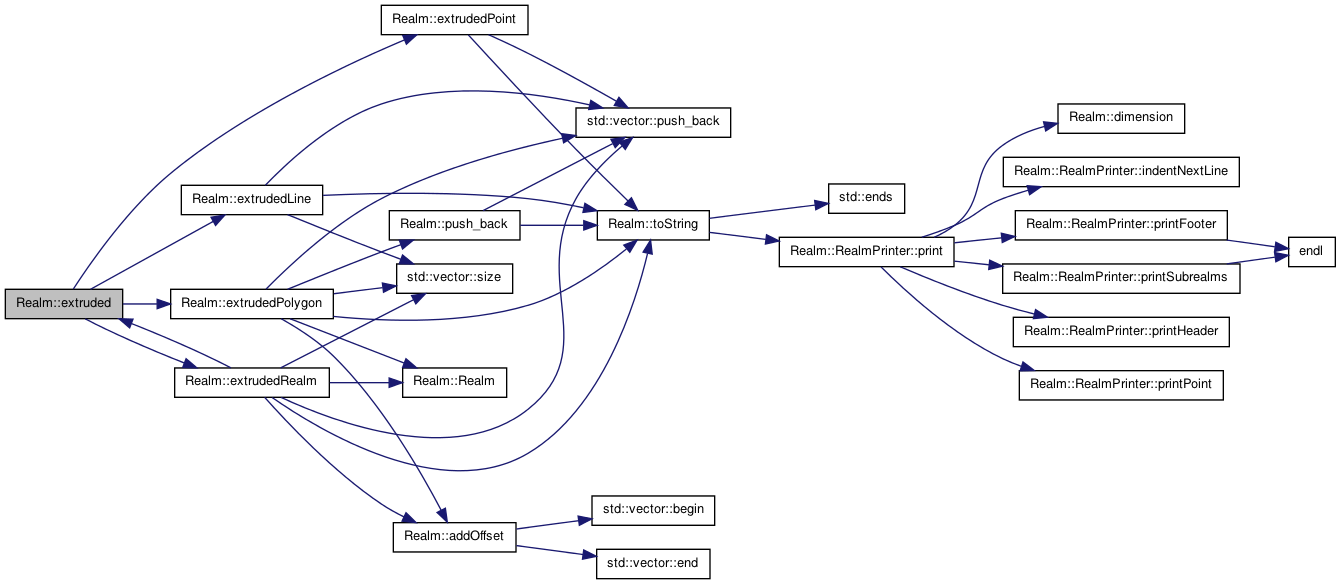

| Realm Realm::extrudedLine | ( | unsigned | delta | ) | const [private] |
Extrude a line to a square.
Special case: make surfaces so OpenGL can draw them. _subrealm.size() should be 2.
References _dimension, _index, _subrealm, std::vector< _Tp, _Alloc >::push_back(), std::vector< _Tp, _Alloc >::size(), and toString().
Referenced by extruded().


| Realm Realm::generateEmpty3DRealm | ( | ) | [static, private] |
References setDimension().
Referenced by rotatedPolygon().


| Realm Realm::generateStripBetweenGreatCircles | ( | unsigned | base, |
| unsigned | delta | ||
| ) | const [private] |
Create a three-dimensional Realm from a polygon for one rotation step.
split procedure: once for points on the positive and once for negative points. what happens and actually seems to be necessary here is this. when i comment out the second loop in the case of a cylinder only half is drawn. in the case of a sphere only a quarter sphere is drawn regardless of whether the second loop runs or not.
i suspect that there should be _subrealm.size()/2 loops of length 2. in the cylinder case, this happens to be the same as what we have here, because _subrealm.size() == 4.
Split into smaller functions.
Fix for triangles.
References push_back(), rectsBetweenGreatCircles(), reorderRectsBetweenGreatCircles(), std::vector< _Tp, _Alloc >::size(), and size().
Referenced by rotateStep().
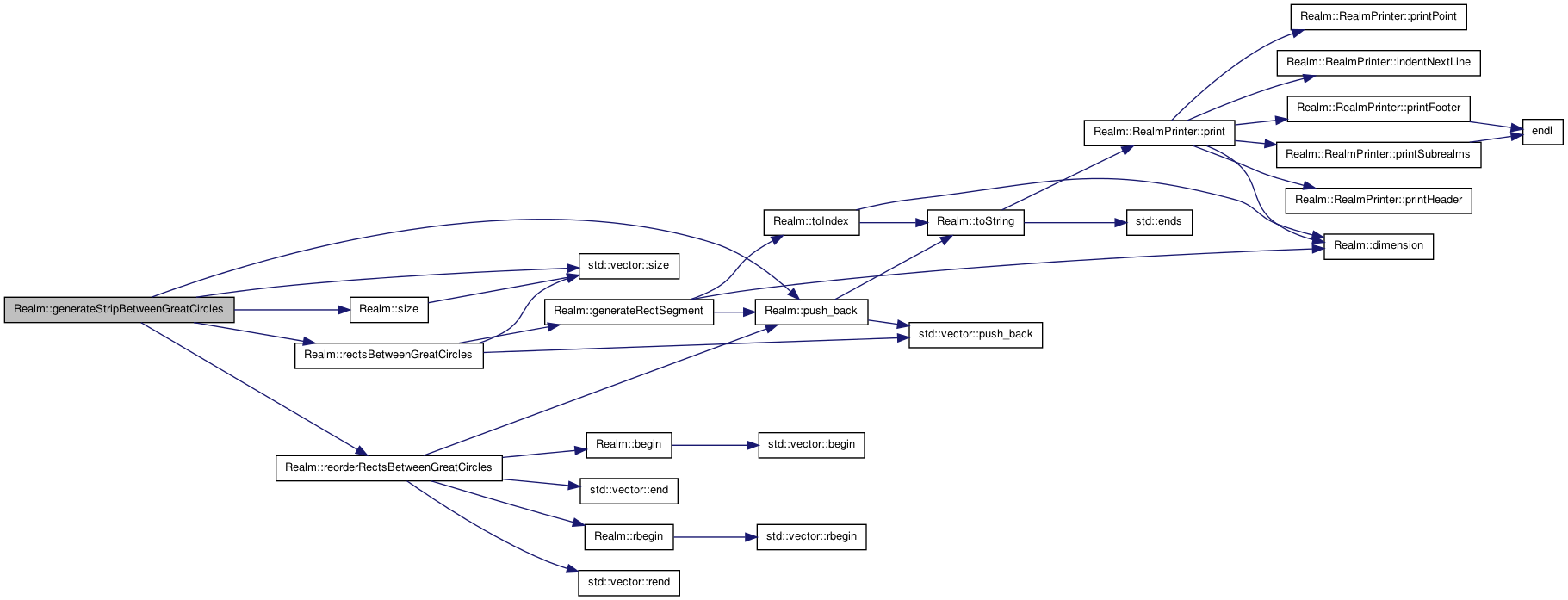

| bool Realm::operator== | ( | const Realm & | other | ) | const |
Whether all the elements in two Realms are equal.
References _subrealm, dimension(), std::vector< _Tp, _Alloc >::size(), and toIndex().

| Realm Realm::rotated | ( | unsigned | num_segments, |
| unsigned | size | ||
| ) | const |
Create a new Realm by rotating the present Realm.
| num_segments | How many segments to use approximating a circle. |
| size | Size of the original vertex array. See extrude(). |
References _dimension, rotatedLine(), rotatedPolygon(), rotatedRealm(), and toString().
Referenced by rotate_base< D >::rotate(), and rotatedRealm().
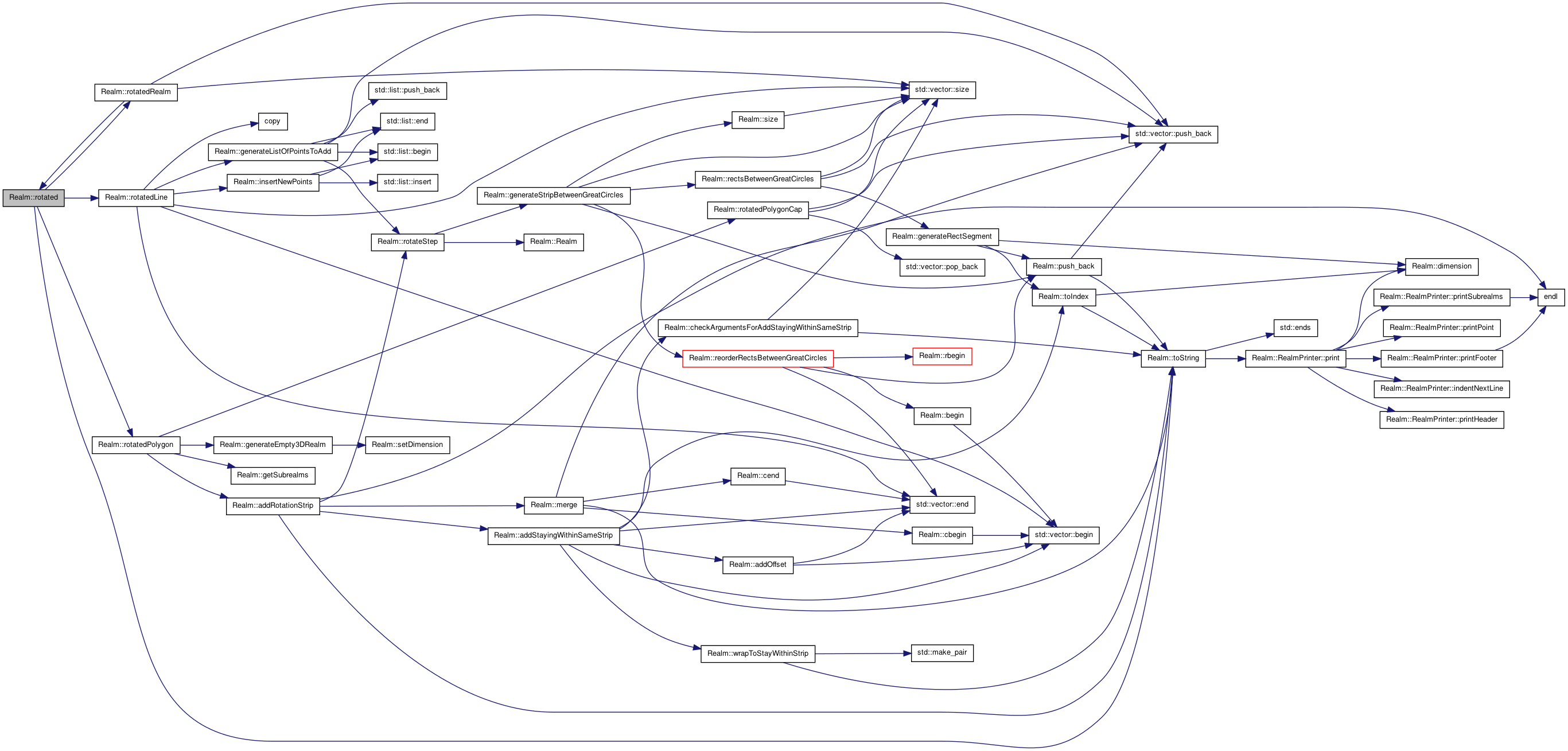

| Realm Realm::rotatedLine | ( | unsigned | num_segments, |
| unsigned | size | ||
| ) | const [private] |
Rotate a line into a polygon approximating a circle.
To rotate a line we must do the following.
Rotate both endpoints of the line num_segments times, first the one, then the other. Connect the last rotated image of the first endpoint to the original second point and the last rotated image of the second point to the first point. If we start with the line [0, 1] and rotate it with num_segments = 3, we get [ 0, 2, 3, 1, 4, 5 ].
| num_segments | How many segments to use approximating a circle. |
| size | Size of the original vertex array. See extrude(). |
Copy the subrealms to a list for easier insertion in the middle.
Copy the subrealms back from the temporary list to a vector
References _subrealm, std::vector< _Tp, _Alloc >::begin(), copy(), std::vector< _Tp, _Alloc >::end(), generateListOfPointsToAdd(), insertNewPoints(), and std::vector< _Tp, _Alloc >::size().
Referenced by rotated().


| Realm Realm::rotatedPolygon | ( | unsigned | num_segments, |
| unsigned | size | ||
| ) | const [private] |
Rotate a polygon into a quasi-sphere, cylinder or cone.
For a two-dimensional surface we have to do the following.
First, because the surface is not stored as a list of lines, but rather as a list of points (because drawing the surface from lines in OpenGL would be too tedious) we have to split the surface corner points into line segments. Say we have a square defined as [0, 1, 3, 2] we must first split it into its edges: [0, 1], [1, 3], [3, 2], [2, 1].
Say we have num_segments = 3. What we want in the end is for the sides of the prism: [0, 1, 5, 4], [4, 5, 7, 6], [6, 7, 3, 2], [2, 3, 9, 8], [8, 9, 11, 10], [10, 11, 1, 0] and for the caps: [0, 4, 6, 2, 8, 10], [1, 5, 7, 3, 9, 11].
Nietzsche said (I paraphrase), "Philosophers are often poor writers because they not only tell us what they think, but also how they developed their thoughts." If I were a good writer, my code would express the solution for the numbering and ordering of indices in a "rotated" Realm clearly. Because I am not, I include my musings as a reference to whom it may concern.
A polygon's indices are numbered like this:
5 * * 3
0 * - original-line - * 1
2 * * 4
A rotation step leads to the following situation, unsatisfactorily depicted in ASCII art.
5 * * 3
11 * * 9 <- rotated up
0,6,12 * * 1,7,13
2 *-----------* 4
\ \ <- one resulting face
rotated down-> 8 *-----------* 10
To generate a polygon strip that adds a surface to all these vertices, we connect each neighboring pair [original vertex, neighboring vertex] and their rotated images. Naively we would just add num_segments (6) to connect to the rotated vertex, then add the offset 2 to connect to the neighbour in the rotated polygon, then subtract 6 again to connect to the neighbor in the original polygon. In traversing the list of vertices we must use each vertex twice, because it is part of two line segments/resulting faces. The idea is to simply add 2 to each vertex in a face, that would lead to the next neighboring face. Let's see how that works out.
[0, 6, 8, 2] -> [2, 8, 10, 4] ok.
[4, 10, 7, 1] -> [6, 12, 13, 3] wrong face! 12 and 13 lie across the center.
[3, 9, 11, 5] -> [5, 11, 13, 7] wrong face again! 5 and 11 don't neighbor 13 and 7.
Clearly, if an "overflow" occurs, ie. vertices are connected to other vertices that do not result from the same rotation step, errors creep in. addKeepingInRange() ensures that the vertices are kept within the same plane:
[0, 6, 8, 2] -> [2, 8, 10, 4] [4, 10, 7, 1] -> [6, 12, 11, 5] [3, 9, 11, 5] -> [5, 11, 6, 0]
References addRotationStrip(), generateEmpty3DRealm(), getSubrealms(), and rotatedPolygonCap().
Referenced by rotated().
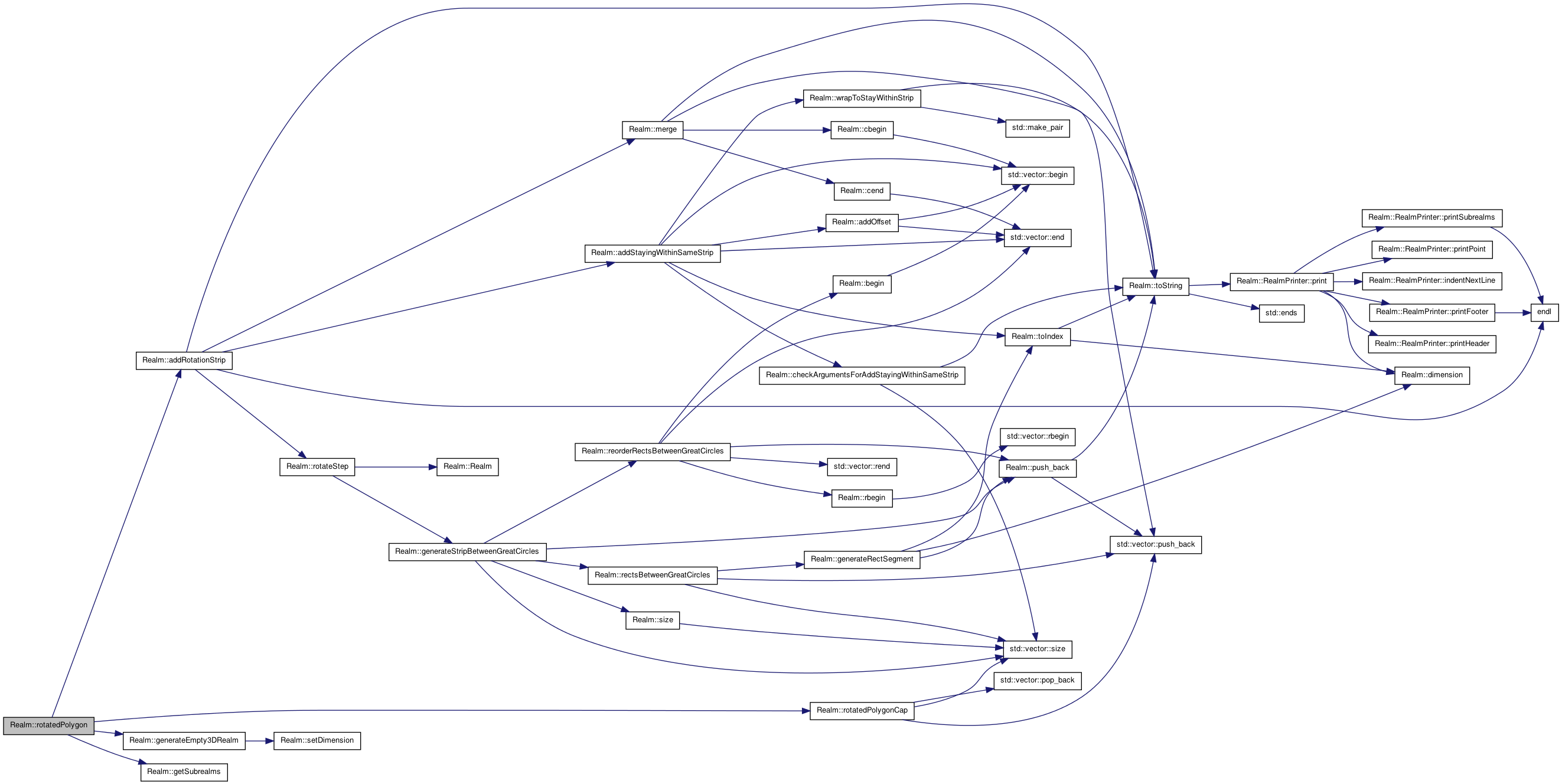

| Realm Realm::rotatedPolygonCap | ( | const realm_container_type & | rotated_walls | ) | const [private] |
Upper and lower cap for a rotated polygon.
Create the cap (perpendicular to the rotation axis).
Make the first edge the first line in the temporary list of subrealms (assuming we have a square). To do that remove the last two vertices from the square.
then add the following edges by using only the first point of the edge
References _subrealm, std::vector< _Tp, _Alloc >::pop_back(), std::vector< _Tp, _Alloc >::push_back(), and std::vector< _Tp, _Alloc >::size().
Referenced by rotatedPolygon().
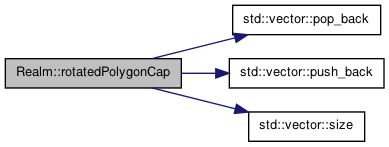

| Realm Realm::rotateStep | ( | unsigned | index, |
| unsigned | base, | ||
| unsigned | delta | ||
| ) | const [private] |
Create a Realm by extruding edges for one step of a rotation.
The edges of the current Realm are rotated about some (clarify!) axis. The resulting image is connected to the current Realm, resulting in a Realm of the same dimension. The total set of thusly created Realms, for all degrees from 0 to 360, constitute the surface Realm of the rotated object. Phoo, another mouthful.
| index | Currently only used for lines. Do I really need it? What is it for? |
| base | |
| delta |
References _dimension, _index, _subrealm, generateStripBetweenGreatCircles(), and Realm().
Referenced by addRotationStrip(), and generateListOfPointsToAdd().
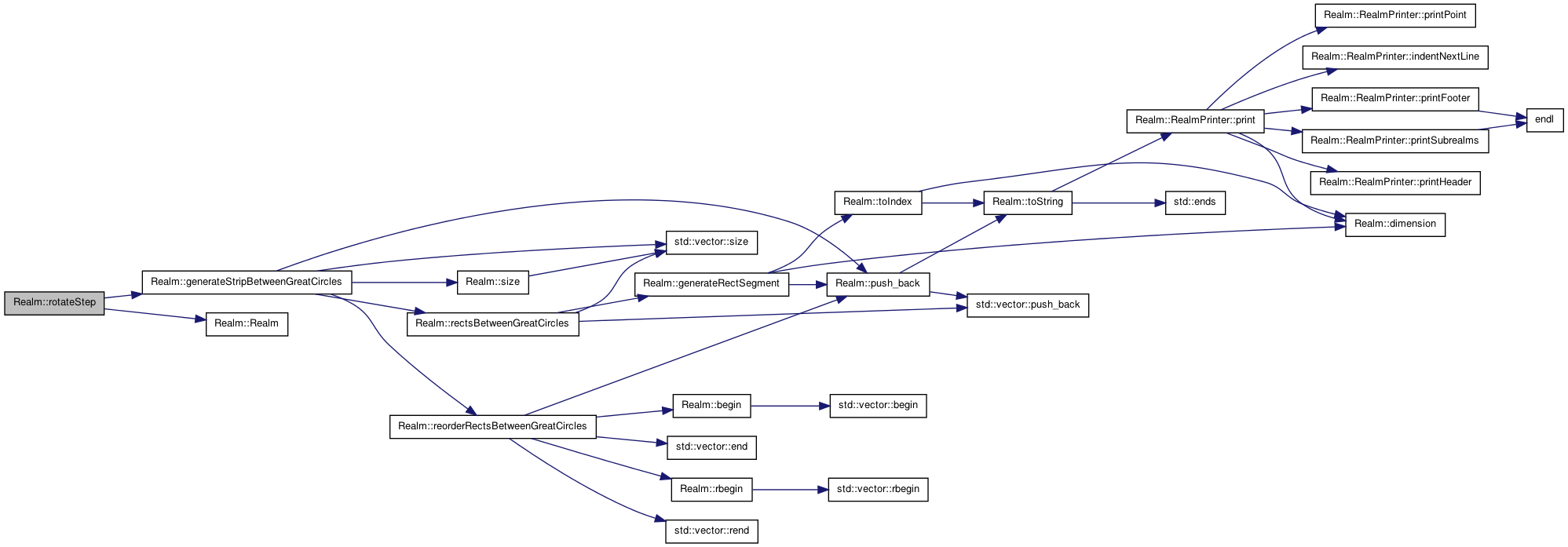

| Realm Realm::tapered | ( | unsigned | taper_index | ) | const |
Create a new Realm by tapering the present Realm.
| taper_index | Index in the vertex array of the new vertex, toward which the object is tapered. |
References _dimension, taperedLine(), taperedPolygon(), taperedRealm(), and toString().
Referenced by taper_base< D >::taper(), and taperedRealm().


 1.7.4
-
Hosted by
1.7.4
-
Hosted by